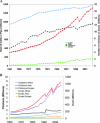Ecology of avian influenza viruses in a changing world
- PMID: 20536820
- PMCID: PMC2981064
- DOI: 10.1111/j.1749-6632.2010.05451.x
Ecology of avian influenza viruses in a changing world
Abstract
Influenza A virus infections result in approximately 500,000 human deaths per year and many more sublethal infections. Wild birds are recognized as the ancestral host of influenza A viruses, and avian viruses have contributed genetic material to most human viruses, including subtypes H5N1 and H1N1. Thus, influenza virus transmission in wild and domestic animals and humans is intimately connected. Here we review how anthropogenic change, including human population growth, land use, climate change, globalization of trade, agricultural intensification, and changes in vaccine technology may alter the evolution and transmission of influenza viruses. Evidence suggests that viral transmission in domestic poultry, spillover to other domestic animals, wild birds and humans, and the potential for subsequent pandemic spread, are all increasing. We highlight four areas in need of research: drivers of viral subtype dynamics; ecological and evolutionary determinants of transmissibility and virulence in birds and humans; the impact of changing land use and climate on hosts, viruses, and transmission; and the impact of influenza viruses on wild bird hosts, including their ability to migrate while shedding virus.
Figures




Similar articles
-
H5N1 outbreaks and enzootic influenza.Emerg Infect Dis. 2006 Jan;12(1):3-8. doi: 10.3201/eid1201.051024. Emerg Infect Dis. 2006. PMID: 16494709 Free PMC article.
-
Changing Role of Wild Birds in the Epidemiology of Avian Influenza A Viruses.Adv Virus Res. 2018;100:279-307. doi: 10.1016/bs.aivir.2017.10.007. Epub 2017 Nov 21. Adv Virus Res. 2018. PMID: 29551140
-
Characterizing wild bird contact and seropositivity to highly pathogenic avian influenza A (H5N1) virus in Alaskan residents.Influenza Other Respir Viruses. 2014 Sep;8(5):516-23. doi: 10.1111/irv.12253. Epub 2014 May 14. Influenza Other Respir Viruses. 2014. PMID: 24828535 Free PMC article.
-
(Highly pathogenic) avian influenza as a zoonotic agent.Vet Microbiol. 2010 Jan 27;140(3-4):237-45. doi: 10.1016/j.vetmic.2009.08.022. Epub 2009 Aug 26. Vet Microbiol. 2010. PMID: 19782482 Review.
-
Origin and evolution of highly pathogenic H5N1 avian influenza in Asia.Vet Rec. 2005 Aug 6;157(6):159-64. doi: 10.1136/vr.157.6.159. Vet Rec. 2005. PMID: 16085721 Review.
Cited by
-
Ecogeographic Drivers of the Spatial Spread of Highly Pathogenic Avian Influenza Outbreaks in Europe and the United States, 2016-Early 2022.Int J Environ Res Public Health. 2023 Jun 1;20(11):6030. doi: 10.3390/ijerph20116030. Int J Environ Res Public Health. 2023. PMID: 37297634 Free PMC article.
-
Persistence of Low Pathogenic Influenza A Virus in Water: A Systematic Review and Quantitative Meta-Analysis.PLoS One. 2016 Oct 13;11(10):e0161929. doi: 10.1371/journal.pone.0161929. eCollection 2016. PLoS One. 2016. PMID: 27736884 Free PMC article.
-
An ecological and conservation perspective on advances in the applied virology of zoonoses.Viruses. 2011 Apr;3(4):379-397. doi: 10.3390/v3040379. Epub 2011 Apr 15. Viruses. 2011. PMID: 21994738 Free PMC article. Review.
-
Predictive power of air travel and socio-economic data for early pandemic spread.PLoS One. 2010 Sep 15;5(9):e12763. doi: 10.1371/journal.pone.0012763. PLoS One. 2010. PMID: 20856678 Free PMC article.
-
Environmental monitoring to enhance comprehension and control of infectious diseases.J Environ Monit. 2010 Nov;12(11):2048-55. doi: 10.1039/c0em00046a. Epub 2010 Oct 19. J Environ Monit. 2010. PMID: 20957286 Free PMC article. Review.
References
-
- Daszak P, Cunningham AA, Hyatt AD. Emerging infectious diseases of wildlife - threats to biodiversity and human health. Science. 2000;287:443–449. - PubMed
-
- Cox NJ, Subbarao K. Global epidemiology of influenza: Past and present. Annu. Rev. Med. 2000;51:407–421. - PubMed
-
- Subbarao K, Klimov A, Katz J, et al. Characterization of an avian influenza A (H5N1) virus isolated from a child with a fatal respiratory illness. Science. 1998;279:393–396. - PubMed
Publication types
MeSH terms
Grants and funding
LinkOut - more resources
Full Text Sources
Medical

